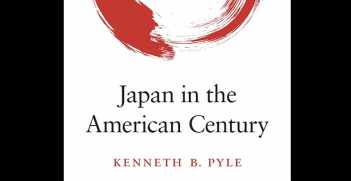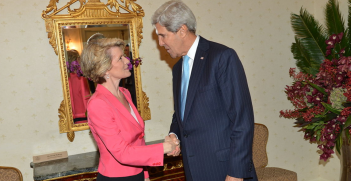Reading Room: Deepening India-Japan Relations

Only a couple of decades ago, scholarly interest in India–Japan relations was almost non-existent. Since the turn of the century and especially in recent years, Japan’s gaze upon India has been transformed by an evolving strategic dimension alongside the rise of China, underscoring deeper mutual interest and the strengthening of all aspects of the bilateral relationship. The collection of essays presented in this book, written by Japanese and Indian scholars, is testimony to the upward swing in this bilateral relationship and worldwide interest in it.
Funded by the Sasakawa Peace Foundation and hosted by the United Nations University in Tokyo, eight pairs of scholars under editors Rohan Mukherjee and Anthony Yazaki have produced essays on four selected themes: economic cooperation, energy and climate change, security and defence and global governance. In their surveys of these themes, the pairs of scholars from India and Japan have attempted to establish where the two nations stand on issues associated with these themes and consider possible aspects of future cooperation as well as current challenges and how to overcome them.
The book’s overall message is unsurprising: the two nations have come far in developing their relationship, especially in the last fifteen years but both need to make much more effort to build more robust and enduring bilateral relations for mutual benefit. Areas of disconnect remain, such as those related to their views on China and the United States, as well as their perceptions of and policy directions towards each other.
On the four specific areas of analysis in the book, some chapters are more substantial than others, which is not unusual for an edited work. The chapters on economic cooperation are fairly mainstream and offer little new analysis or research in areas like trade and investment. The analysis on energy and climate change issues is new and potentially a source of valuable insight. Yet these two chapters lack analytical depth, partly because, as Nobuo Tanaka and Anthony Yazaki observe, ‘Japan and India’s cooperation appears to be more episodic and ad hoc rather than systematic’. The chapter by Shyam Saran and Radhika Khosla largely echoes these views.
The chapters on security and defence are very well written. While Japan and India have developed strong ties in security and defence, Noboru Yamaguchi and Shutaro Sano observe `Japan–India bilateral cooperation is still in its primary stages`. They urge caution in claiming, `it is crucially important for both (India and Japan) not to be perceived by Beijing as trying to contain China through their bilateral cooperation efforts`, and recommend a multilateral security framework for cooperation. C. Raja Mohan and Rishika Chauhan offer similarly cautious assessment, voicing the view that ‘Deepening bilateral strategic cooperation without provoking China, then, is the greatest political challenge for both capitals.’.
The final two pairs analysing global governance issues explore the areas where Japan and India can cooperate and the challenges they face in doing so. Shinichi Kitaoka and Naoko Kumagai essentially focus on Japan’s position on international institutions and acknowledge the inevitability of challenges given ‘significant differences in national interests between Japan and India’. Waheguru Pal Singh Sidhu and Karthik Nachiappan offer their assessment of India–Japan cooperation in shaping multilateral rules and institutions in a systematic and analytical fashion. They recommend that the two nations strengthen where their interests converge such as maritime security and try to work cooperatively through challenges in managing areas where their interests diverge, e.g., nuclear order.
In the book’s concluding section, the editors note that the two countries ‘will have to overcome their differences’ apparent in their national ethos, business and government bureaucracy. They end the book on an optimistic note, observing that ‘while clearly requiring careful tending, this bilateral relationship holds great promise for the two countries, their continent and the world.
Overall, I welcome this volume as an up-to-date introductory book on India–Japan relations. The book focuses on selective areas for analysis that will help to inform readers about some aspects of this increasingly important relationship between two of Asia’s three ‘giants’. Yet it is silent on some aspects that could be of significant interest to many readers. One example is Japan’s already substantial and still growing aid to India; exploration of how the two nations could be partners when India is also becoming a significant aid donor could be of immense value. Some authors in the volume do note this aspect briefly, but a deeper analysis of it would have enriched this book’s contribution to knowledge, since very little has been written on this topic. The editors’ claim that goodwill ‘is the most that can be said about the role of foreign aid as a potential driver of deeper bilateral relations’ is unfortunate, given the scale and importance of Japan’s aid to India.
The editors’ introduction reveals that the book is intended to be ‘a comprehensive work on foreign policy analysis and a ready handbook for practitioners on both sides of the relationship who might seek a deeper understanding of its opportunities and challenges’. This is a rather grand claim, which I believe the editors largely fail to deliver. The book at best can serve as a helpful primer for the uninitiated. For specialists and practitioners alike, its content and analysis offer little that deepens insight or advances conceptual thinking.
It is interesting to note that the scholars who have contributed to this book do not specialise on the India–Japan relationship, while country specialists have been deliberately excluded. This appears to have been intentional to bring to light fresh perspectives on the bilateral relationship. Unfortunately though, if this was the objective, it remains largely unfulfilled. Perhaps a combination of one India/Japan specialist and one study discipline (e.g., economics, IR) specialist would have positioned this book to offer greater depth and analytical insights than the volume now offers. I hope the funding agency and the editors will keep this constructive observation in mind if and when launching a new volume of this kind.
Rohan Mukherjee and Anthony Yazaki, Poised for Partnership: Deepening India-Japan Relations in the Asian Century, New Delhi: Oxford University Press, 2016.
Purnendra Jain is a professor in the Department of Asian Studies at the University of Adelaide.




